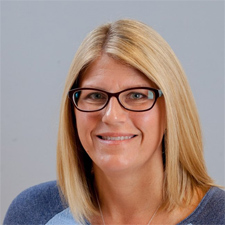Lab members

Rachel Neilson
Senior Research Technician
Education
B.S. Clinical Laboratory Science (Concentration in Molecular Biotechnology) - University of Kansas Medical Center
B.S. Clinical Laboratory Science (Concentration in Molecular Biotechnology) - University of Kansas Medical Center
Bio
Rachel joined the Hawley Lab in June 2003 after receiving a B.S. in Clinical Laboratory Science (Molecular Biotechnology) from KUMED. She has used genetics, high resolution cytology, and molecular biology techniques to study chromosome pairing and recombination during meiosis in Drosophila melanogaster. Currently, she works primarily on proteins that are required for DNA double strand breaks and crossover maturation. She is also exploring a system that uses fluorescently-tagged fly embryos to screen for mutants that alter crossover interference. She is also the lab’s safety officer.
Selected Publications
Narya, a RING finger domain-containing protein, is required for both meiotic DNA double-strand break formation and crossover maturation in Drosophila melanogaster
Lake CM, Nielsen RJ, Bonner AM, Eche S, White-Brown S, McKim KS, Hawley RS. PLoS Genet. 2019;15:e1007886. doi: 1007810.1001371/journal.pgen.1007886.
Original Data
Vilya, a component of the recombination nodule, is required for meiotic double-strand break formation in Drosophila.
Lake CM, Nielsen RJ, Guo F, Unruh JR, Slaughter BD, Hawley RS. eLife. 2015;4:e08287. doi: 08210.07554/eLife.08287.
Original Data
Corolla is a novel protein that contributes to the architecture of the synaptonemal complex of Drosophila.
Collins KA, Unruh JR, Slaughter BD, Yu Z, Lake CM, Nielsen RJ, Box KS, Miller DE, Blumenstiel JP, Perera AG, Malanowski KE, Hawley RS. Genetics. 2014;198:219-228.
Original Data
The Drosophila zinc finger protein trade embargo is required for double strand break formation in meiosis.
Lake CM, Nielsen RJ, Hawley RS. PLoS Genet. 2011;7:e1002005.
A Germline Clone Screen for Meiotic Mutants in Drosophila melanogaster
Page SL, Nielsen RJ, Teeter K, Lake CM, Ong S, Wright KR, Dean KL, Agne D, Gilliland WD, Hawley RS. Fly.2007;1:172-181.
Narya, a RING finger domain-containing protein, is required for both meiotic DNA double-strand break formation and crossover maturation in Drosophila melanogaster
Lake CM, Nielsen RJ, Bonner AM, Eche S, White-Brown S, McKim KS, Hawley RS. PLoS Genet. 2019;15:e1007886. doi: 1007810.1001371/journal.pgen.1007886.
Original Data
Vilya, a component of the recombination nodule, is required for meiotic double-strand break formation in Drosophila.
Lake CM, Nielsen RJ, Guo F, Unruh JR, Slaughter BD, Hawley RS. eLife. 2015;4:e08287. doi: 08210.07554/eLife.08287.
Original Data
Corolla is a novel protein that contributes to the architecture of the synaptonemal complex of Drosophila.
Collins KA, Unruh JR, Slaughter BD, Yu Z, Lake CM, Nielsen RJ, Box KS, Miller DE, Blumenstiel JP, Perera AG, Malanowski KE, Hawley RS. Genetics. 2014;198:219-228.
Original Data
The Drosophila zinc finger protein trade embargo is required for double strand break formation in meiosis.
Lake CM, Nielsen RJ, Hawley RS. PLoS Genet. 2011;7:e1002005.
A Germline Clone Screen for Meiotic Mutants in Drosophila melanogaster
Page SL, Nielsen RJ, Teeter K, Lake CM, Ong S, Wright KR, Dean KL, Agne D, Gilliland WD, Hawley RS. Fly.2007;1:172-181.



